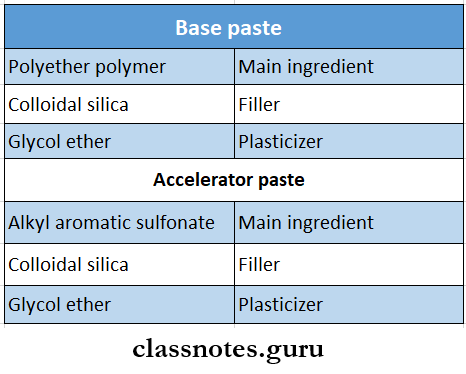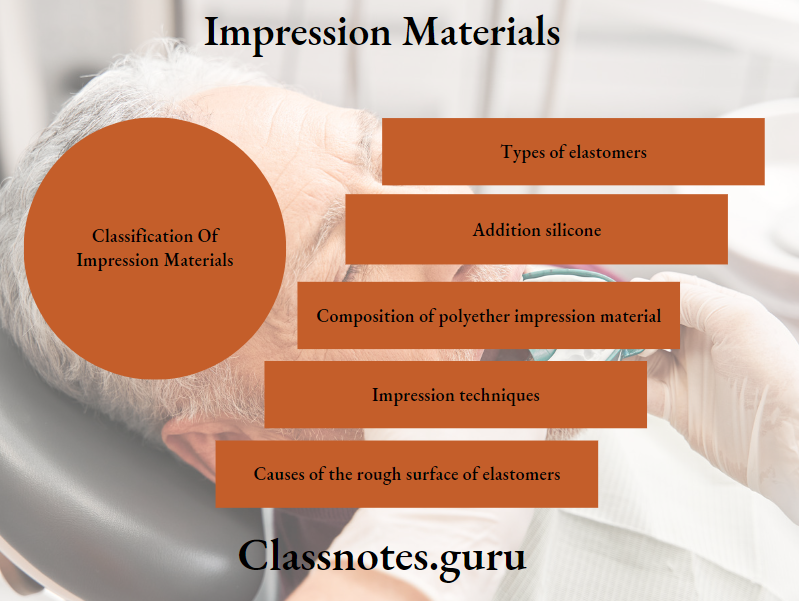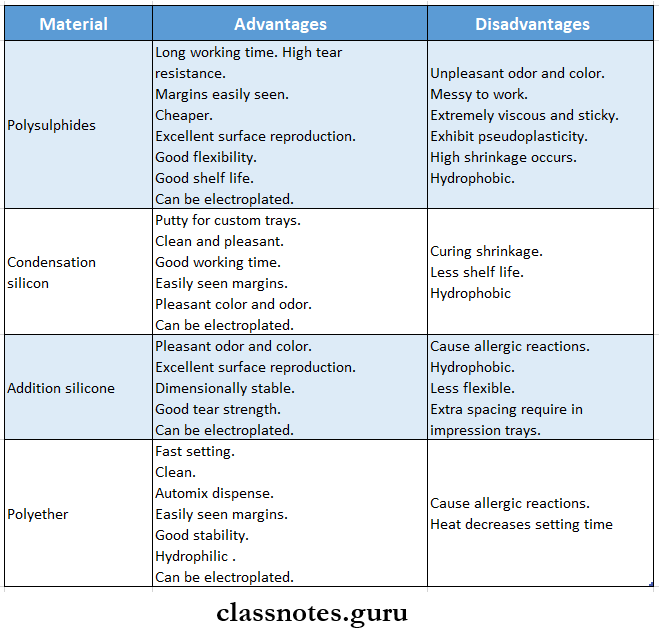Impression Materials Important Notes
1. Classification Of Impression Materials
- Based On Setting Mechanisms
- Chemical reaction
- Plaster of Paris — Zinc oxide eugenol
- Alginate
- Nonaqueous elastomers
- Thermally-induced physical reaction
- Compound wax
- Agar
- Chemical reaction
- Based On Elasticity
- Rigid materials
- Plaster of Paris
- Zinc oxide eugenol
- Compound
- Rigid materials
- Elastic Material
- Agar
- Alginate
- Non-aqueous elastomers
2. Types Of Elastomers

3. Addition Silicone
- Addition Silicone are type II silicone impression materials
- In addition Silicone undergoes an additional type of polymerization terminating in vinyl groups and cross-linked with hydride group
- In addition Silicone has very little residual polymerization
- Thus it is the most dimensionally stable
- Addition Silicone is highly biocompatible
- Addition Silicone Advantages:
- Dimensionally stable
- Adequate tear strength
- Pleasant odor and color
- Multiple casts can be made from one impression
- No volatile byproduct
- Addition Silicone Disadvantage
- Impurities evolve hydrogen gas
- This hydrogen gas produces pinpoint voids in the stone casts if poured immediately
- It is prevented by
- Adding platinum or palladium
- By delaying the pouring of impression
Read And Learn More: Dental Materials Question and Answers
4. Composition Of polyether Impression Material

5. Impression Techniques
- Multiple Mix technique
- Two separate mixes are made
- Heavy body material is placed in the tray
- Light body is loaded in a syringe
- Impression is made
- Single Mix
- Only one mix is made
- Medium body material is used
- Part of it is loaded in a tray and part is loaded in a syringe
- Impression is made
Alginate Impression Material
6. Causes Of The Rough Surface Of Elastomers
- Incomplete polymerization caused by premature removal from the mouth
- The improper ratio of mixing components
- Too rapid polymerization caused by high humidity and high temperature

Impression Materials Long Essay
Question 1. State the properties and uses of rubber-based materials
Answer:
Rubber Based Materials:
Rubber Based Materials Synonyms:
- Rubber impression materials
- Elastomeric impression materials
Rubber Based Materials Properties:
- They are accurate impression material- they excellently reproduce the surface details
- They are dimensionally stable
- Available in various viscosity
- The low viscosity is capable of reproducing even very fine details
- They are generally hydrophobic
- Resilience
- They are flexible with near-complete elastic recovery
- Its coefficient of thermal expansion Is high
- It cannot melt, before melting they pass Into a gaseous state
- They swell In the presence of certain solvents
- They are Insoluble
- They have lower creep resistance
- Tear strength is excellent
- They can be electroplated
- As they don’t adhere well to the Impression tray, tray adhesive is used
- It has a shelf life of about two years
- It may cause dimensional changes due to
- Curing shrinkage
- Loss of byproducts
- Hydrophilic nature
- Thermal contraction
- Delayed pouring of cast
Rubber Based Materials Uses:
- In fixed partial dentures for Impressions of prepared teeth
- Impressions of dentulous mouths for removable partial dentures
- Impressions of edentulous mouths for complete dentures
- Polyether Is used for border molding
- For bite registration
- Silicon Is used for making refractory casts
Dental Impression Techniques
Question 2. Advantages and disadvantages of elastomeric Impression material
Answer:
Advantages And Disadvantages Of Elastomeric Impression Material

Question 3. What are elastomers? Write in detail about the types, composition, properties, and manipulation of additional silicone impression material.
Answer:
Elastomers:
- It is a lightly cross-linked impression material that exhibits elastic behavior after setting.
- It refers to a group of rubbery polymers, which are either chemically or physically cross-linked
Addition Silicones:
Addition Silicones Types:
- It is available in four viscosities
- Light bodied
- Medium bodied
- Heavy bodied
- Putty
Addition Silicones Composition:
![]()
Addition Silicones Properties:
![]()
- Setting time-5-9 minutes
- Mixing time- 45 seconds
- Shelf life 1 to 2 years
Manipulation:
1. For The Paste
- Dispense equal length of base and catalyst over a mixing pad
- Incorporate first the catalyst into the base
- Mixing is done by moving the spatula back and forth on the mixing pad
- The process is continued until the mixed paste is uniform in color with no streaks of the base or catalyst
2. For Putty
- An equal number of scoops of each putty is dispensed
- Material is then kneaded with fingers until a uniform color is obtained
Question 4. Classify impression materials and describe in detail about contents, setting, and properties of silicone rubber base impression materials
Answer:
Silicone Rubber Classification:
1. Based On Setting Mechanisms
- Chemical Reaction
- Plaster of Paris
- Zinc oxide eugenol
- Alginate
- Nonaqueous elastomers
- Thermally-Induced Physical Reaction
- Compound wax
- Agar
2. Based On Elasticity
- Rigid Materials
- Plaster of Paris
- Zinc oxide eugenol
- Compound wax
- Elastic Material
- Agar
- Alginate
- Nonaqueous elastomers
Silicon Rubber Based Materials: Silicon rubber-based materials are
- Condensation silicone
- Addition silicone
![]()
Impression Materials Short Essays
Question 1. What are nonaqueous elastomers and write any one of their compositions?
Answer:
Nonaqueous Elastomers:
Nonaqueous elastomers are
- Polysulphides
- Polyether
- Condensation silicone
- Addition Silicones
![]()
Accuracy Of Impression Materials
Question 2. Ideal requirements of Impression materials
Answer:
Ideal Requirements:
- They should be fluid enough to adapt to oral tissues
- Should be viscous enough to be contained in the tray that is seated in the mouth
- While in the mouth, they should set into a rubbery or rigid solid in a reasonable amount of time
- The set impression should not tear or distort when removed
- The impression made should be dimensionally stable
- Stability should be maintained after the removal of a cast so that a second or third cast can be made
- The material should be biocompatible
- It should be cost-effective
- Should be nontoxic
- Should be acceptable to patients with pleasant odor and color
- Should have an adequate shelf life
- Easy to use with minimum equipment
- Should have adequate strength
- Should be compatible with the die and cast materials
- Should be able to be electroplated
Question 3. Polysulphides
Answer:
Polysulphides
Polysulphides were the first elastomeric impression material to be introduced
Polysulphides Advantages:
- Long working time
- High tear resistance
- Margins easily seen
- Cheaper
- Excellent surface reproduction
- Good flexibility
- Good shelf life
- Can be electroplated
Polysulphides Disadvantages:
- Unpleasant odor and color
- Messy to work
- Extremely viscous and sticky
- Exhibit pseudo plasticity
- High shrinkage occurs
- Hydrophobic
Polysulphides Composition:
- Base
- Liquid polysulfide polymer
- Inert fillers
- Reactor
- Lead dioxide
- Dibutyl phthalate
- Sulfur
- Other substances like magnesium stearate and deodorants
Advantages And Disadvantages Of Impression Materials
Question 4. Elastomers
Answer:
Elastomers
- A lightly cross-linked impression material that exhibits elastic behavior after setting is called elastomer
- They contain large molecules with weak Interaction between them
- They are liquid polymers that can be converted to solid rubber at room temperature
Elastomers Types:
1. According to Chemistry
- Polysulphides
- Condensation silicone
- Addition silicone
- Polyether
2. According to Viscosity
- Light body
- Medium body
- Heavy body
- Very heavy body
3. According to Elasticity
- Type 1
- Type 2
- Type 3
4. According to Wettability
- Hydrophilic
- Hydrophobic
Elastomers Uses:
- In fixed partial dentures for impressions of prepared teeth
- Impressions of dentulous mouths for removable partial dentures
- Impressions of edentulous mouths for complete dentures
- Polyether is used for border molding
- For bite registration
- Silicon is used for making refractory casts
Question 5. Reline technique for elastomeric impression
Answer:
Reline Technique For Elastomeric Impression
- Reline technique is also called the two-stage putty wash technique
- It is used to minimize the effect of Polymerisation shrinkage
Elastomeric Impression Technique:
- The thick putty material is made using a stock tray
- Results in preliminary impression
- Spacing is provided by either
- Cutting away some of the tray putties or
- Using a thin polyethylene sheet between putty and prepared tooth
- The mix of thin consistency wash material is placed into putty
- Putty wash and tray are seated into the mouth
- The final impression is made
Classification Of Impression Materials
Question 6. Condensation silicon
Answer:
Condensation Silicon
Condensation silicone is one of the silicone impression material
Condensation Silicon Composition:
1. Base
- Polymethyl siloxane
- Colloidal silica
- Color pigments
2. Accelerator
- Orthoethyl silicate
- Stannous octoate
Condensation Silicon Advantages:
- Putty for custom trays
- Clean and pleasant
- Good working time
- Easily seen margins
- Pleasant color and odor
- Can be electroplated
Condensation Silicon Disadvantages:
- Curing shrinkage
- Less shelf life
- Hydrophobic
Impression Materials Short Question And Answers
Question 1. Rubber-based impression material
Answer:
Rubber-Based Impression Material
- It is a lightly cross-linked impression material that exhibits elastic behavior after setting.
- It refers to a group of rubbery polymers, which are either chemically or physically cross-linked
Rubber-Based Impression Material Uses:
- In fixed partial dentures for impressions of prepared teeth
- Impressions of dentulous mouths for removable partial dentures
- Impressions of edentulous mouths for complete dentures
- Polyether is used for border molding
- For bite registration
- Silicon is used for making refractory casts
Properties Of Dental Impression Materials
Question 2. Addition silicone
Answer:
In addition, silicone is the most widely used impression material
Addition Silicone Advantages:
- Pleasant odor and color
- Excellent surface reproduction
- Dimensionally stable
- Good tear strength
- Can be electroplated
Addition Silicone Disadvantages:
- Cause allergic reactions
- Hydrophobic
- Less flexible
- Extra spacing is required in impression trays
Question 3. Cross-linking
Answer:
Cross-linking
The joining of polymer chains to form a three-dimensional network structure is called cross-linking
Question 4. Polyether
Answer:
Polyether
- Polyether was introduced in Germany
- It has good mechanical properties and dimensional stability
Polyether Advantages:
- Fast setting
- Clean
- AutomLx dispense
- Easily seen margins
- Good stability
- Hydrophilic
- Can be electroplated
Polyether Disadvantages:
- Cause allergic reactions
- Heat decreases the setting time
Properties Of Dental Impression Materials
Question 5. Tray adhesives.
Answer:
Tray Adhesives
- Tray adhesives are tacky liquids that are applied with a brush
- They are used to obtain the most accurate impression possible by adhering impression material to the tray
- Tray Adhesives is advisable to use tray adhesive on all trays before making an impression
Each elastomer has a specific adhesive
Tray Adhesives Method Of Application:
- Apply a thin layer of tray adhesive to the tray using the applicator brush
- Allow to dry for at least 3 minutes
- Load the tray with impression material
- Make an impression
Question 6. Multiple mix impression technique of elastomers.
Answer:
Multiple Mix Impression Techniques Of Elastomers
- Two separate mixes are made
- Heavy body material is placed in the tray
- Light body is loaded in a syringe
- Impression is made
